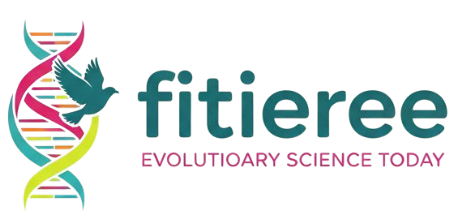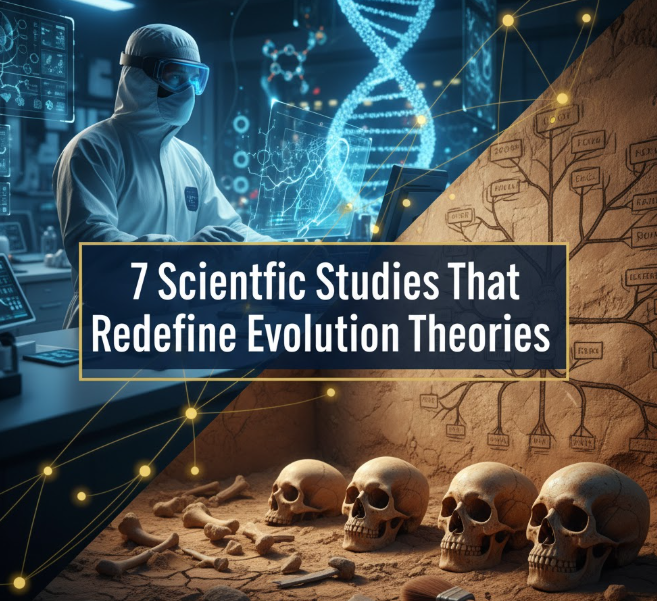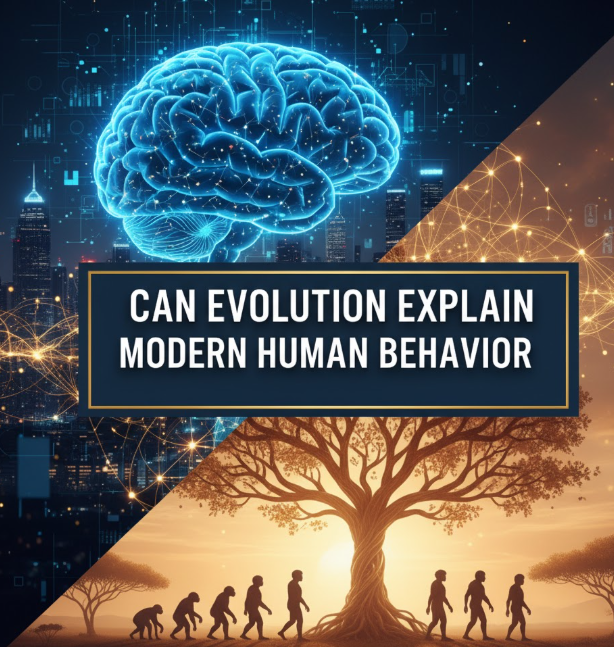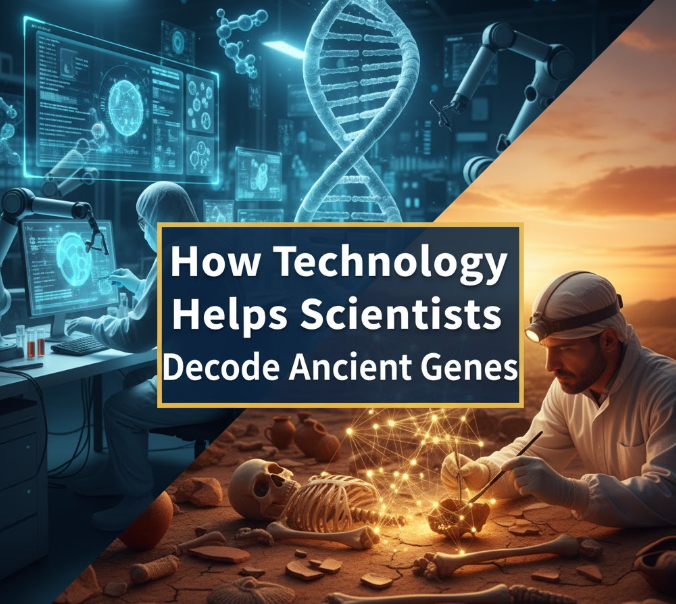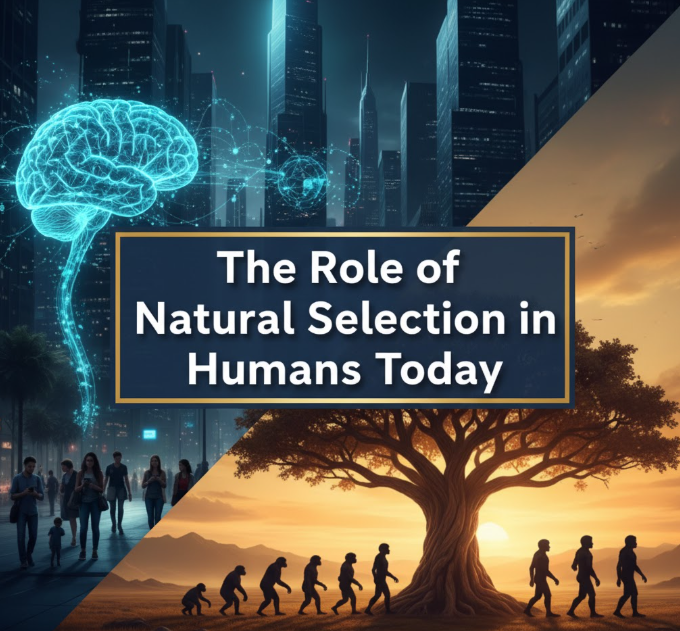Evolution is not just some musty old textbook subject — it’s a living, breathing science that continues to amaze us. For 150 years Charles Darwin’s theory of natural selection has been the bedrock for how we think about life on Earth. But contemporary scientists are finding out that evolution is even more complicated, cool and bizarre than anyone knew.
With recent advances in genetics, paleontology and molecular biology, researchers are being forced to reconsider some long-held thinking about how species change over time. Other findings contradict or totally revolutionize the prevailing “survival of the fittest” story. These are not minor tweaks of existing ideas; they are game changers that transform our entire conception of life’s history.
In this piece, we are going to look at seven amazing scientific studies that have revolutionized one’s thinking about how evolution works. From rogue bacteria defying the rules of inheritance to birds that evolved twice, these discoveries show just how much weirder and more wonderful evolution is than we ever could have imagined. Prepare to see the natural world through an entirely new lens.
The Revelation That Genes Aren’t Everything
For years scientists have believed that evolution occurs when patches of DNA are copied and expressed in an organism’s offspring without being altered, allowing for the chance that new traits favored by natural selection might eventuate. If you wanted to know how a species evolved, all you had to do was gaze into its genes, no? Wrong. Thanks to a cutting-edge science called epigenetics, that assumption is being blown out of the water.
What Epigenetics Revealed
It was a group of researchers at the University of Cambridge who conducted a study of water fleas that blew all its predecessors out of the water. What they found was that environmental stress — from predators and other challenges — could bring on changes in gene expression that were inherited by the next generation, even when the DNA sequence itself hadn’t changed. It’s a bit like somebody scribbling notes in the margin of a book, never altering what’s on the page.
This would mean that organisms can inherit characteristics their parents acquired in the course of their lifetime, which sounds suspiciously like Jean-Baptiste Lamarck’s old theory that scientists dismissed 200 years ago. But here’s the catch: Epigenetic modifications don’t actually rewrite a person’s genetic code — they just determine which genes are activated or silenced. It is like owning a huge playlist of songs, only you get to skip tracks without eliminating them.
Why This Matters for Evolution
With epigenetic inheritance comes a whole new dimension of evolutionary change. Organisms can evolve in response to selective pressures far more rapidly than by conventional genetic mechanisms. If instead, a population encounters a sudden drought, perhaps epigenetic shifts could permit them to adapt within a literal lifetime rather than banking on tens of thousands of years for the exact mutation that would help.
This discovery has massive implications. It means that evolution is not just about random mutations and natural selection — it’s also about how organisms actively respond to their environment and transmit those responses to the next generation. The process of evolution has suddenly appeared to be a good deal more dynamic and flexible than the slow, grinding change we heard about in school.
When Bacteria Swap Genes Like Baseball Cards
If you assumed that genes can pass only from parent to child, think again. Scientists who study bacteria have found something called horizontal gene transfer, and it’s completely nutso.
How Bacteria Break the Rules
“Orthodox evolution,” as Albert questions this old view, takes a straightforward form: genes travel up and down between parents and offspring. But bacteria do not play by those rules. In fact they can literally exchange genes with utterly unrelated bacteria, even from different species. It would be like if you could all of a sudden train yourself to breathe under water by shacking up with a fish for an excessive amount of time.
One groundbreaking study in Science traced the spread of antibiotic resistance among populations of bacteria. The scientists discovered that genes for resistance spread rapidly between entirely different species of bacteria, potentially in as little as a matter of hours. In a single bacterium, immunity to an antibiotic is borne, then that genetic resistance is circulated like notes in class.
The Evolutionary Game-Changer
This finding totally turns our idea of how evolution works in bacteria on its head. “If you picture a nice clean tree of life rooted in some primeval node, where everything is interacting through descent and the movement of genetic material,” Ms. Adam said, “it’s really a whole bunch of knots.”
It is horizontal gene transfer that enables bacteria to become frighteningly antibiotic resistant so quickly. It’s not the story of a single species gradually mutating — it’s the story of an entire microbial community passing around survival strategies, like some sort of underground network. (For medicine, agriculture and our understanding of how life first evolved, the implications are enormous.)
| Type of Gene Transfer | Traditional Inheritance | Horizontal Transfer |
|---|---|---|
| Direction | One generation to next | Unrelated organisms |
| Speed | Generational | Hours or days |
| Distribution | All complex life | Most prevalent in bacteria |
| Evolutionary Effect | Slow, gradual change | Rapid evolution |
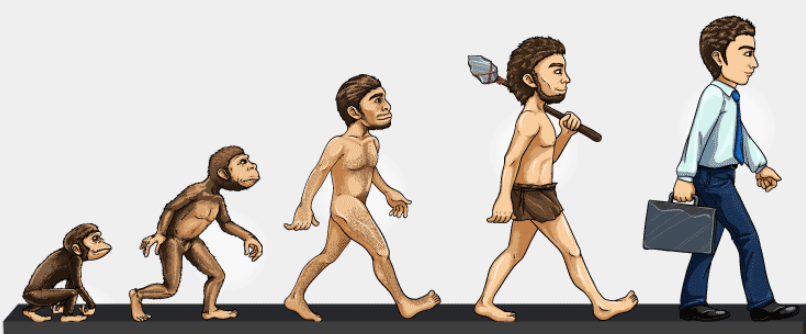
Evolution Doesn’t Always Move Forward
This is going to mess with your head, but sometimes evolution runs in reverse. A study on fish dwelling in caves found that evolution can even erase traits that took millions of years to develop.
The Blind Fish Mystery
The Mexican blind cavefish are the epitome of regressive evolution. These fish descended from perfectly normal, fully sighted ancestors, but generations of life in pitch-black caves caused their eyes to vanish entirely. University of Maryland researchers even studied their DNA, and found something astonishing: the genes for eyes are there – but turned off.
And why the hell would evolution get rid of something like eyes? The answer is surprisingly practical. Eyes use a ton of energy to be built and maintained. In a place where seeing provides no benefit, that energy could be better applied elsewhere—to building a more sensitive lateral line system that detects vibrations in the water.
Rethinking Progress in Evolution
This discovery goes against the commonly held idea that evolution constantly leads to more complex or “better” organisms. Losing characteristics can remain the smartest evolutionary moves. It’s not about becoming “better”—it’s about becoming better suited to your environment at the moment.
Such regressive evolution occurs more frequently than one might suspect. Whales lost their rear legs, snakes lost their limbs and many island birds became flightless. Each loss is an evolutionary benefit in a given scenario. There’s no aiming or assisting in evolution — it’s all about survival and procreation wherever you find yourself living.
The Species That Evolved Twice
Evolution is meant to be a one-way street. When a species goes extinct, it’s gone forever, isn’t it? One of the most bizarre evolutionary oddities ever documented has to do with rails (the type of bird) from the Indian Ocean island of Aldabra— and it suggests that survival is completely optional.
The Rails That Just Wouldn’t Die
Rails are flightless birds that repeatedly colonized Aldabra island over thousands of years. Here’s where it gets weird: The island was submerged under water in a huge flooding event about 136,000 years ago that drowned out everything living there, including the flightless rails.
But once the island rose again, Madagascar’s rails colonized it anew. And here’s the kicker — they turned into flightless birds once more and with eerily similar features to the already extinct ones. They studied fossils before and after the flooding, and found that both lineages evolved incredibly similar physical characteristics: reduced wing bones and stronger leg architecture.
What Iterative Evolution Means
This phenomenon, known as iterative evolution, reveals that under the right conditions, evolution can be surprisingly predictable. Put the same species in the same environment, and maybe it evolves the same way twice. It’s as if you’re rewinding the tape of life and playing it again.
This finding implies that evolution is not as random as we previously believed. The pressures of environment can be so strong that it forces evolution down the same lines, at different times. It’s a little like the way different societies invented the wheel independently — some solutions are so well suited for certain problems that they crop up over and over.
Your Immune System Evolves as You Age
When we think of evolution, we tend to visualize changes occurring over many generations. But what if in just one human lifetime, evolution could potentially sway a population from being rundown by disease to being well? Immune system studies show that the process of Darwinian evolution is occurring currently within your body.
The Evolution Happening Inside You
In the process of defending your body against infections, your immune system employs a trick called somatic hypermutation. As it turns out, and considering that this editor is not a scientist myself, when one of these new pathogens invades your body, immune cells immediately begin to produce millions of similar — but slightly different — versions of antibodies. The best-fitting antibodies against the invader proliferate, while the less effective ones die off. Sound familiar? It’s natural selection on a warp-speed clip inside your body.
One study in Nature Immunology followed how B cells, a type of immune cell, change to fight HIV. Scientists witnessed the evolution of antibodies as they mutated, becoming better at neutralizing the virus. Some antibodies cycled through dozens of “generations” of evolution in only a small number of months, gaining helpful mutations at a pace that would take an entire organism millions of years.
Evolution on Fast-Forward
This finding suggests that evolutionary principles work across other scales — not just over millennia for species, but within a single organism over months or days — and could even contribute to differing human disease risks. Your immune system, in essence, is an evolutionary laboratory that runs millions of experiments at once to find the best solution to each new threat.
Knowledge of this process has transformed the field of vaccine science and immunotherapy. By learning how antibodies evolve naturally, scientists can create more effective vaccines and treatments for diseases like cancer and HIV. Evolution isn’t just ancient history — it’s happening right now, in every living thing.
The Virus in the Back of Our Minds
Here’s something that might blow your mind: About 8 percent of your DNA is viral. Seriously. Not only is this viral genetic material not rubbish, it has been an important player in human invention.
How Viral DNA Shaped Humanity
Millions of years ago, the sperm or egg cells of our ancestors were infiltrated by viruslike entities known as retroviruses, which wove their DNA into ours. Those viral genes became a part of the human genome, incorporated into DNA that continued to be passed down from generation to generation. For years, scientists believed these sequences were just useless baggage — evolutionary remnants with no function.
But a new study published in Cell showed that some of these very same viral genes are actually necessary for human existence. One of the viral genes helps build the placenta, which is the organ that feeds growing babies in the womb. Without this vestige of ancient viral DNA, we could never be born as the humans that exist today.
Viruses as Evolution’s Secret Weapon
This finding turned scientists’ understanding of the viral role in evolution upside down. Viruses are not just disease-causing entities that can prompt pandemics and other threats, they’re also drivers of innovative evolutionary designs. By shuffling around genes among various organisms, viruses have sped up evolution and developed entirely new biological features that never would have arisen through just normal mutations alone.
The implications are mind-blowing. Viral DNA has shaped the evolution of not just our brain and immune system but also, as some scientists now say, of we humans themselves. Parts of what we think of as fundamentally “human” are in fact the legacy of ancient viral infections. Evolution is not merely a world of competition and survival of the fittest, but also one of cooperation, integration with other life forms (including viruses), flexibility and mutual dependence.
Learn more about how viruses have shaped human evolution from Nature.
Evolution in Action: A Case of Superfast Evolution
So evolution is meant to happen over millions of years, isn’t it? Which is what makes a study of lizards on the Bahamas so special — researchers observed evolution happen in just under a year.
The Hurricane That Proved Darwin Right
In 2017, researchers from Harvard University were studying anole lizards on a number of small Caribbean islands just as Hurricane Irma struck. The category 5 storm was quite the catastrophe, but it also caused a natural experiment. After the hurricane had come and gone, researchers found that the surviving lizards exhibited traits distinct from those of the pre-storm population.
These survivors had larger toe pads and longer front legs — features that would have helped them stick to branches in high winds. The lizards that did not possess these traits were actually blown away by the storm. The average characteristics of the population had changed noticeably in one generation. Natural selection had occurred in the blink of an eye, right before the eyes of the scientists.
What Rapid Evolution Teaches Us
This study is a blow to the notion that evolution proceeds slowly and gradually. Populations can evolve massively in just a few generations when environmental pressures are intense. To be clear, it’s not as if the lizards magically evolved bigger toe pads during the storm — the genetic variation was already there in that population. The hurricane only decided which variants made it through to spread their genes.
This fast pace matters for how species might respond to climate change. As habitats change more rapidly than ever, some species may be able to adapt fast enough to survive. Others won’t be so lucky. The factors that enable rapid evolution may be crucial for conservation efforts and predicting which species will make it through to the end of the next century.
The Future Implications of These Findings
These seven are only a small sampling of the groundbreaking work being done to rewrite evolutionary biology. Taken together, they offer a picture of evolution that is far more intricate and active — and interesting — than the one we learned in school.
Evolution isn’t a one-way, steady march toward progress. We’re flexible, too: We swap genes and we respond to the environment (even by integrating retroviruses into our own genome), adapting quickly when running forward won’t serve, even doing it backward when that’s called for. It works at many scales at once — from cells battling infections inside your body to species evolving over millions of years.
The Bigger Picture
What makes these discoveries so exciting isn’t only that they are neat science facts (which, of course, they are). And they are put to use in the real world, shaping our daily lives. Studying epigenetics enables us to see how environment can impact health from one generation to the next. Understanding horizontal gene transfer describes antibiotic resistance, and informs medical interventions. Knowing that evolution can happen quickly would allow scientists to predict how species might respond to something like climate change.
Most crucially, these studies serve as a reminder that science isn’t a static canon of knowledge — it’s an ongoing conversation. Every answer raises new questions. Every discovery opens new doors. The history of the evolution of evolutionary theory reads like an example of evolution in itself: consistently changing and adjusting to new information.
Where Do We Go From Here?
The potential of evolutionary research is exhilaratingly so. Thanks to technological advances, scientists can observe evolution in action, watch genetic changes sweep through populations and see mechanisms Darwin never could have dreamed of. We are creating the tools to not just witness evolution, but perhaps influence it in beneficial directions — though that comes with ethical qualms we’re just beginning to sort out.
These seven studies demonstrate that we’re in a golden age of evolutionary biology. The next game-changing find might be around the corner, and could rewrite our understanding of things anew. And that’s the magic of science: It is never done surprising us.
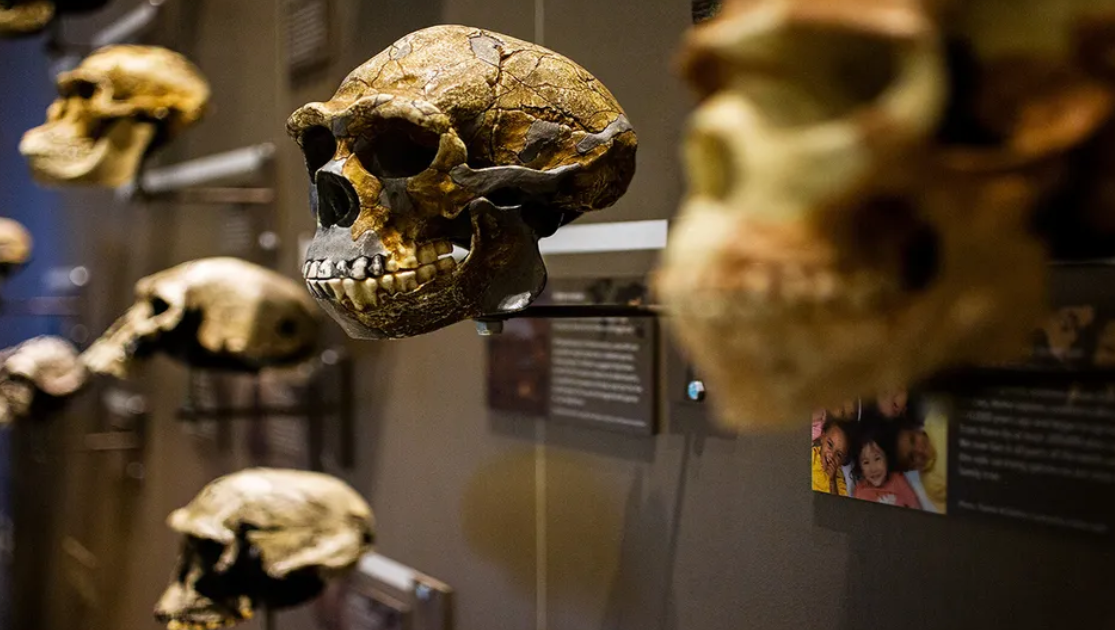
Frequently Asked Questions
What is the biggest challenge to modern evolutionary theory?
The most likely game-changer is the discovery of epigenetic inheritance. It reveals that organisms can transmit traits to their offspring other than by adding or deleting genes, because of changes created by problem-solving or general organismal demand during the life cycle that are stored in some kind of information inherited from the parent’s germline. (This could include proteins, RNA molecules and chemical changes to DNA.) It makes evolution operate far faster — with a system Wallace called “the first step toward Lamarckism”— than via waiting for new mutations in germ cells changing the sequence of A’s, T’s, C’s and G’s.
Can evolution really be that quick, as these studies propose?
Absolutely. Although some evolutionary changes require millions of years, others occur after just a few generations when the environmental pressure is strong enough. The lizard hurricane experiment showed that measurable evolution can take place in a year.
Are humans capable of horizontal gene transfer?
Not the way it does in bacteria. Humans and other complex organisms do not share genes with unrelated species over the course of their lifetime. But we did take up viral DNA from ancient infections, and those sequences have become integrated in our genome.
Are these findings controversial in the scientific world?
Not particularly. These results have been published in peer-review journals and are uniformly held by the scientific community. They do not upend evolution — they deepen and enhance our understanding of how it works.
How do genetic mutations differ from epigenetic changes?
This is the moment when genetic mutations rewrite the sequence of DNA just as if they had edited words in a sentence. Epigenetic modifications don’t change the words themselves; they simply determine what gets emphasized or de-emphasized in a given context — sort of like underlining different sentences using the same words.
What does this mean for the teaching of evolution in schools?
These findings also indicate that evolutionary education should be broader than natural selection and mutation. The students need to understand concepts such as epigenetics, horizontal gene transfer and the various mechanisms for evolutionary change. The tale is trickier but also more interesting than the simpler one.
Would humans evolve that quickly, as did the lizards in the hurricane study?
In principle, yes, but human generation times are far longer than those of lizards so it takes awhile. Also, advanced medicines and technology often counteract the selective pressure for change (which would otherwise lead to faster evolution). But our immune systems also evolve quickly over the course of our own lifetimes — in response to new diseases.
